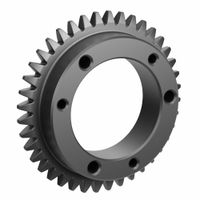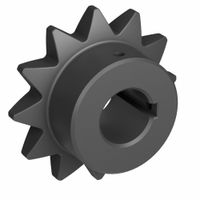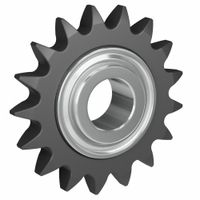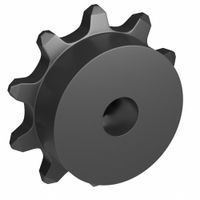Call +(254) 703 030 000 / 751 483 999 / 721 704 777
- Home
- Power Transmission
- Roller Chains Sprockets
- Roller Chain Sprockets Idlers
.....Read More
Frequently Asked Questions
What is the difference between fixed-bore and plain-bore roller chain sprockets?
Fixed-bore and plain-bore roller chain sprockets differ primarily in their design and application flexibility.
Fixed-bore sprockets come with a pre-machined bore size and keyway, ready for immediate installation. They are designed for specific shaft sizes and are often used in applications where the shaft size is standardized and does not require customization. The keyway and set screws are already in place, ensuring a secure fit on the shaft. This makes fixed-bore sprockets convenient for quick replacements or installations in systems where the shaft dimensions are known and consistent.
Plain-bore sprockets, on the other hand, are supplied with an unfinished bore. This allows for customization to fit a variety of shaft sizes and configurations. Users can machine the bore to the desired diameter and add keyways or set screws as needed. This flexibility makes plain-bore sprockets ideal for applications where the shaft size may vary or where custom fitting is required. They are often used in prototyping, custom machinery, or situations where the exact specifications of the shaft are not predetermined.
In summary, the main difference lies in the level of customization and readiness for installation. Fixed-bore sprockets offer convenience and speed for standard applications, while plain-bore sprockets provide adaptability for custom or non-standard setups.
How do I choose the right size sprocket for my application?
To choose the right size sprocket for your application, consider the following factors:
1. **Application Requirements**: Determine the specific needs of your application, such as speed, torque, and power transmission. This will guide the selection of the sprocket size and type.
2. **Chain Size**: Identify the chain size you are using, as sprockets must match the chain pitch and width. Chain size is typically specified in terms of pitch (distance between chain pins) and roller diameter.
3. **Number of Teeth**: The number of teeth on the sprocket affects the gear ratio, which influences speed and torque. A larger sprocket (more teeth) increases torque but reduces speed, while a smaller sprocket (fewer teeth) increases speed but reduces torque.
4. **Gear Ratio**: Calculate the desired gear ratio by dividing the number of teeth on the driven sprocket by the number of teeth on the driving sprocket. This ratio determines the mechanical advantage and performance characteristics of the system.
5. **Center Distance**: Ensure the sprocket size allows for the correct center distance between the driving and driven shafts. This affects chain tension and alignment.
6. **Material and Durability**: Choose a sprocket material that suits the operating environment. Common materials include steel, stainless steel, and plastic. Consider factors like load, wear resistance, and environmental conditions.
7. **Space Constraints**: Evaluate the available space for the sprocket. Ensure it fits within the mechanical design without interference.
8. **Alignment and Mounting**: Ensure proper alignment and secure mounting to prevent premature wear and failure. Check for compatibility with the shaft size and keyway.
9. **Manufacturer Specifications**: Consult manufacturer guidelines and specifications for recommended sprocket sizes and configurations for your specific application.
By considering these factors, you can select a sprocket that optimizes performance, efficiency, and longevity for your application.
What is the purpose of an idler sprocket?
An idler sprocket is a component used in chain drive systems to guide and maintain tension in the chain. Its primary purpose is to ensure the smooth operation of the chain by preventing slack, reducing vibration, and minimizing wear on the chain and other sprockets. By maintaining proper tension, the idler sprocket helps in optimizing the efficiency and longevity of the entire drive system.
Idler sprockets are typically mounted on a fixed or adjustable bracket, allowing them to be positioned to take up slack in the chain. This adjustability is crucial in systems where the chain length may change due to thermal expansion, wear, or other factors. By keeping the chain taut, the idler sprocket ensures consistent engagement with the drive and driven sprockets, which is essential for accurate power transmission and timing.
In addition to tensioning, idler sprockets can also be used to change the direction of the chain path, allowing for more compact or complex system designs. This flexibility is particularly useful in applications with limited space or where the chain needs to navigate around obstacles.
Overall, the idler sprocket plays a vital role in maintaining the performance and reliability of chain drive systems, making it an essential component in various mechanical and industrial applications.
How do I install a bushed-bore sprocket?
1. **Select the Correct Sprocket and Bushing**: Ensure you have the right size and type of sprocket and bushing for your application.
2. **Prepare the Shaft**: Clean the shaft thoroughly to remove any dirt, rust, or debris. Ensure the shaft is smooth and free of burrs.
3. **Install the Bushing into the Sprocket**: Align the bushing with the sprocket's bore. Insert the bushing into the sprocket, ensuring the holes in the bushing align with the holes in the sprocket.
4. **Insert the Bolts**: Place the bolts through the sprocket and into the threaded holes of the bushing. Do not fully tighten them yet.
5. **Mount the Assembly on the Shaft**: Slide the sprocket and bushing assembly onto the shaft to the desired position. Ensure the keyway in the bushing aligns with the keyway on the shaft if applicable.
6. **Insert the Key**: If your setup requires a key, insert it into the keyway on the shaft and bushing.
7. **Tighten the Bolts**: Gradually tighten the bolts in a crisscross pattern to ensure even pressure. Use a torque wrench to tighten the bolts to the manufacturer's specified torque settings.
8. **Check Alignment**: Ensure the sprocket is properly aligned with the other components in the drive system. Adjust as necessary.
9. **Secure the Assembly**: Once aligned, fully tighten the bolts to the specified torque. Double-check the alignment and make any final adjustments.
10. **Final Inspection**: Verify that the sprocket is securely mounted and that there is no play or misalignment. Ensure all components are properly secured.
11. **Test the System**: Run the system at low speed to ensure everything operates smoothly. Check for any unusual noises or vibrations. Adjust if necessary.
What materials are roller chain sprockets typically made from?
Roller chain sprockets are typically made from a variety of materials, each chosen based on the specific application requirements, including strength, wear resistance, and cost. Common materials include:
1. **Steel**: The most prevalent material for roller chain sprockets, steel offers excellent strength and durability. Carbon steel is often used for general applications, while alloy steels are chosen for high-stress environments due to their enhanced mechanical properties. Heat-treated or hardened steel sprockets are used in applications requiring high wear resistance.
2. **Stainless Steel**: Used in environments where corrosion resistance is crucial, such as in food processing, chemical, or marine applications. Stainless steel sprockets are resistant to rust and can withstand harsh conditions, although they are generally more expensive than carbon steel options.
3. **Cast Iron**: Known for its good wear resistance and machinability, cast iron is used in applications where the sprocket is not subjected to high impact or shock loads. It is cost-effective and provides adequate performance for many industrial applications.
4. **Plastic/Polymer**: Used in applications where noise reduction, lightweight, or corrosion resistance is important. Plastic sprockets are common in food processing and packaging industries. They are not as strong as metal sprockets but offer advantages in specific environments.
5. **Bronze**: Occasionally used for sprockets in applications requiring low friction and good wear resistance. Bronze sprockets are suitable for low-speed applications and environments where lubrication is challenging.
6. **Aluminum**: Lightweight and corrosion-resistant, aluminum sprockets are used in applications where weight is a critical factor, such as in racing or aerospace. However, they are not as durable as steel or stainless steel sprockets.
The choice of material depends on factors like load, speed, environmental conditions, and cost considerations.
How do I maintain and lubricate roller chain sprockets?
To maintain and lubricate roller chain sprockets, follow these steps:
1. **Inspection**: Regularly inspect the sprockets for wear, damage, or misalignment. Look for signs of wear such as hooked teeth, which indicate the need for replacement.
2. **Cleaning**: Clean the sprockets and chain to remove dirt, debris, and old lubricant. Use a brush and a suitable solvent or degreaser. Ensure the components are dry before applying new lubricant.
3. **Alignment**: Check the alignment of the sprockets and chain. Misalignment can cause uneven wear and reduce the lifespan of both the chain and sprockets. Adjust as necessary to ensure proper alignment.
4. **Tension**: Ensure the chain tension is correct. A chain that is too tight or too loose can cause excessive wear. Follow the manufacturer's specifications for the correct tension.
5. **Lubrication**: Use a high-quality lubricant specifically designed for roller chains. Apply the lubricant to the inside of the chain where it contacts the sprocket teeth. This ensures the lubricant reaches the pins and bushings, reducing friction and wear.
6. **Lubrication Frequency**: Lubricate the chain and sprockets regularly, depending on the operating conditions. For high-speed or high-load applications, more frequent lubrication may be necessary.
7. **Environment Considerations**: Consider the operating environment. In dusty or dirty environments, use a lubricant that resists contamination. In wet conditions, use a water-resistant lubricant.
8. **Record Keeping**: Maintain a log of maintenance activities, including inspections, cleaning, and lubrication. This helps track the condition of the sprockets and chain over time.
By following these steps, you can extend the life of your roller chain sprockets and ensure efficient operation.
What are the signs of wear or damage in a roller chain sprocket?
Signs of wear or damage in a roller chain sprocket include:
1. **Tooth Wear**: Look for hooked, pointed, or excessively worn teeth. This indicates the sprocket is worn out and may not engage the chain properly.
2. **Tooth Deformation**: Check for bent or broken teeth, which can result from excessive force or improper alignment.
3. **Surface Wear**: Examine the sprocket surface for signs of pitting, galling, or scoring, which can occur due to inadequate lubrication or contamination.
4. **Chain Fit**: A loose fit between the chain and sprocket can indicate wear. The chain should fit snugly without excessive play.
5. **Noise and Vibration**: Unusual noise or vibration during operation can signal misalignment or wear in the sprocket.
6. **Material Fatigue**: Look for cracks or fractures in the sprocket material, which can result from repeated stress or overloading.
7. **Corrosion**: Rust or corrosion on the sprocket can weaken its structure and lead to premature failure.
8. **Uneven Wear**: Check for uneven wear patterns, which can indicate misalignment or improper tensioning of the chain.
9. **Sprocket Alignment**: Misalignment can cause uneven wear and should be checked regularly.
10. **Excessive Backlash**: Excessive movement between the chain and sprocket can indicate wear and lead to inefficient power transmission.
Regular inspection and maintenance are crucial to identify these signs early and prevent further damage or failure.




